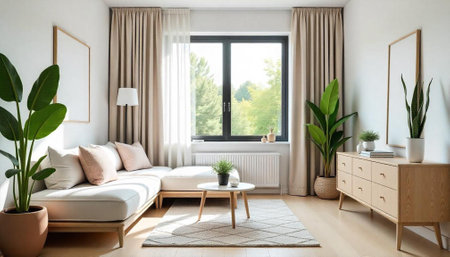Introduction to Flooring Choices in British Homes
Choosing the right flooring is a fundamental decision for any UK household, impacting not only the look and feel of your living space but also its comfort, practicality, and long-term value. British homes are renowned for their diversity in architectural styles, ranging from charming Victorian terraces to contemporary new builds, and this variety plays a significant role in shaping flooring preferences. Beyond aesthetics, homeowners across the UK must consider factors such as climate, insulation needs, foot traffic, and ease of maintenance when selecting suitable materials. The unpredictability of British weather—often damp and chilly—means that durability and resistance to moisture can be just as important as style. Additionally, lifestyle choices, family composition, and even regional trends influence what flooring options become popular in different parts of the country. In essence, choosing the right floor is about striking a balance between tradition and innovation while ensuring that your choice enhances both the function and character of your home.
Classic Carpet: Warmth and Comfort
Carpet has long been a beloved flooring choice in British homes, cherished for its unmatched ability to provide warmth and comfort underfoot. As a staple of interior design across the UK, carpets not only contribute to a cosy atmosphere but also serve as an effective thermal insulator—helping households retain heat during those chilly British winters. Available in a wide array of textures, patterns, and colours, carpets suit both traditional and contemporary tastes, making them an adaptable option for any room.
The Benefits of Carpeting in British Homes
| Benefit | Description |
|---|---|
| Thermal Insulation | Keeps rooms warmer by retaining heat, reducing energy bills. |
| Sound Absorption | Minimises noise transmission between floors—ideal for flats and terraced houses. |
| Aesthetic Variety | Offers endless design possibilities to complement any décor. |
| Comfort Underfoot | Provides a soft, cushioned surface perfect for bedrooms and lounges. |
Popular Types of Carpets in the UK
The most common carpet types found in British homes include wool, synthetic blends (such as polypropylene or nylon), and natural fibres like sisal. Wool is prized for its durability and luxurious feel, while synthetic options are often chosen for their stain resistance and affordability.
Wool vs. Synthetic Carpets: A Quick Comparison
| Type | Pros | Cons |
|---|---|---|
| Wool | Durable, naturally flame-retardant, excellent insulation. | Higher cost, may require specialist cleaning. |
| Synthetic | Stain-resistant, budget-friendly, easy maintenance. | Less luxurious feel, can flatten over time. |
Practical Maintenance Tips for Carpets
- Regular Vacuuming: Vacuum at least twice a week to remove dust and prevent dirt build-up—especially important in high-traffic areas such as hallways and stairs.
- Treat Stains Promptly: Blot spills immediately with a clean cloth and use a suitable carpet cleaner to avoid permanent staining.
- Professional Cleaning: Arrange professional deep cleaning once every 12–18 months to refresh fibres and extend the carpets lifespan.
- Shoes Off Policy: Encourage family and guests to remove shoes upon entering to minimise dirt transfer from outside.
- Use Mats: Place doormats at entrances to trap grit before it reaches your carpeted areas.
Whether you favour plush pile or durable looped textures, carpets continue to be a practical yet stylish solution in British interiors—offering comfort, character, and lasting value when cared for correctly.
![]()
3. Timber Flooring: Timeless Appeal with a British Twist
Timber flooring remains a quintessential choice for British homes, blending tradition and modernity in equal measure. Within the UK, three primary types of timber flooring stand out: hardwood, engineered wood, and laminate. Each offers unique advantages in terms of durability, character, and suitability for the often unpredictable British climate.
Hardwood Flooring: Classic Elegance and Endurance
Hardwood floors are widely regarded as a symbol of sophistication and enduring value. Oak, ash, and beech—woods native to Britain—are particularly popular choices. These species provide not only resilience against daily wear but also develop a distinct patina over time, adding character to period properties and contemporary spaces alike. While hardwood is more susceptible to moisture than some alternatives, proper sealing and regular maintenance ensure it stands the test of time.
Engineered Wood: The Practical British Favourite
Engineered wood has seen a surge in popularity across the UK due to its adaptability and stability. Composed of multiple layers topped with real wood veneer, this flooring resists warping caused by fluctuating humidity—a common concern in British homes. Engineered boards can be installed over underfloor heating systems, making them especially appealing for modern living. They emulate the look and feel of solid hardwood while offering easier installation and greater resistance to environmental changes.
Laminate Flooring: Style Meets Affordability
For those seeking the aesthetic appeal of timber without the higher cost or maintenance demands, laminate flooring presents an ideal solution. Advances in design mean today’s laminates convincingly mimic the grain patterns and textures of real wood, including popular British styles like rustic oak or walnut. Laminate is highly durable, scratch-resistant, and easy to clean—making it a practical option for busy households and high-traffic areas.
Choosing the Right Timber for Your Home
The most commonly chosen woods in Britain include oak for its hard-wearing nature and timeless grain, beech for its subtle warmth, and walnut for a touch of luxury. Each type complements traditional Victorian terraces as well as sleek new builds. When selecting timber flooring, consider not just aesthetics but also the specific requirements of each room—such as moisture levels and expected foot traffic—to ensure long-lasting satisfaction.
Maintenance Tips for Lasting Beauty
No matter your chosen timber style, regular cleaning with suitable products is essential. Periodic resealing or oiling helps protect hardwood surfaces, while engineered wood typically needs less attention but still benefits from gentle care. Laminate requires little more than sweeping and occasional damp mopping. By investing in routine maintenance tailored to your floor type, you’ll preserve both appearance and structural integrity for years to come.
4. Stone and Tile: Durability for Kitchens and Bathrooms
Stone and tile flooring remain a steadfast choice in British homes, particularly in high-traffic and moisture-prone areas such as kitchens, bathrooms, and hallways. Their resilience to daily wear, coupled with their ease of maintenance, makes them a practical yet stylish solution for both period properties and contemporary builds.
Types of Stone and Tile Flooring
| Material | Main Features | Typical Use in UK Homes |
|---|---|---|
| Natural Stone (Slate, Limestone, Travertine) | Authentic look, highly durable, unique patterns, cool underfoot | Kitchens, utility rooms, entrance halls; suits traditional cottages and modern open-plan spaces alike |
| Ceramic Tiles | Wide design options, water-resistant, budget-friendly | Bathrooms, splashbacks, conservatories; commonly found in Victorian terraces and new-builds |
| Porcelain Tiles | Denser than ceramic, excellent stain resistance, mimics natural materials | Kitchens, wetrooms, high-traffic corridors; ideal for busy family homes or rental properties |
Resilience and Longevity
Both stone and tile floors are lauded for their long-lasting nature. When installed correctly on a solid subfloor and sealed where required (especially for natural stone), they can withstand decades of use. Porcelain tiles are especially robust against chipping and water ingress—an important factor considering the British climate’s frequent dampness.
Upkeep and Maintenance Tips
- Sweep or vacuum regularly to avoid grit scratching the surface.
- Mop with pH-neutral cleaners suitable for stone or tile to prevent damage from harsh chemicals.
- Seal natural stone periodically to protect against staining and moisture penetration.
Common Problems and Solutions
| Issue | Prevention/Maintenance Tip |
|---|---|
| Grout discolouration | Use a grout sealer annually; clean spills promptly. |
| Limescale build-up (common in hard water areas) | Treat with a mild vinegar solution (avoid acidic products on limestone or marble). |
Style Fit: Traditional vs Modern British Homes
The adaptability of stone and tiles allows them to complement any interior scheme. In period homes, flagstone or encaustic tiles enhance heritage aesthetics. In contrast, large-format porcelain tiles with minimal grout lines suit sleek modern interiors. Underfloor heating compatibility is another plus—particularly appreciated during chilly British winters.
5. Vinyl and Lino: Practical Solutions for Family Living
When it comes to balancing durability, aesthetics, and cost, vinyl and linoleum (lino) flooring have long been favourites in British homes. These materials have evolved significantly from their earlier incarnations, now offering a wide range of designs that mimic wood, stone, and ceramic tiles—making them ideal for both contemporary family dwellings and the renovation of period properties.
Hardwearing Choices for Everyday Life
Modern vinyl and lino are engineered to withstand the demands of busy households. Their robust construction resists scratches, dents, and everyday wear, making them well-suited for high-traffic areas such as kitchens, hallways, and utility rooms. This resilience is particularly appreciated by families with children or pets, where accidental spills and muddy footprints are part of daily life.
Water Resistance: A Must-Have for British Homes
The unpredictable British weather means wet shoes and dripping coats are a common occurrence. Vinyl’s water-resistant nature ensures that splashes or spills won’t seep through to the subfloor, reducing the risk of damp-related issues. Linoleum also offers excellent moisture resistance when properly sealed, making both options practical choices for bathrooms and laundry areas.
Perfect for Period Property Renovations
For those renovating Victorian terraces or Edwardian semis, authenticity matters. Both vinyl and lino can be selected in heritage patterns or subtle hues that complement original features while delivering modern comfort. They provide a sympathetic update that preserves the property’s character without compromising on practicality or ease of maintenance.
In summary, vinyl and linoleum are not only affordable but also offer stylish, low-maintenance solutions suited to the realities of British family living. Whether you’re updating a bustling family kitchen or restoring a period home, these materials provide reliable flooring that stands up to daily life while enhancing your home’s overall aesthetic.
6. Eco-Friendly Flooring: Sustainable British Choices
As environmental awareness continues to grow across the UK, more homeowners are turning towards eco-friendly flooring options that minimise their carbon footprint without compromising on style or durability. Sustainable flooring is now a key consideration in British homes, blending modern aesthetics with responsible sourcing and manufacturing.
Bamboo: A Fast-Growing Favourite
Bamboo has surged in popularity due to its rapid renewability and impressive strength. Unlike traditional hardwoods, bamboo matures in just a few years, making it an attractive option for those seeking both sustainability and longevity. It offers a contemporary look well-suited to urban flats or period properties alike, and is readily available from reputable UK suppliers who adhere to responsible harvesting practices.
Cork: Comfort and Insulation
Cork flooring is another sustainable choice gaining traction in Britain. Harvested from the bark of cork oak trees—which naturally regenerate—cork provides excellent thermal and acoustic insulation, perfect for busy family homes or flats with neighbours below. Its soft underfoot feel and inherent resistance to mould and mildew make it particularly popular in kitchens and living areas.
Recycled-Content Flooring: Giving Materials a Second Life
British manufacturers increasingly offer flooring made from recycled materials, such as reclaimed wood, recycled glass tiles, and carpet tiles produced from recovered fibres. These options not only divert waste from landfills but also introduce unique textures and character into British interiors. Reclaimed timber floors are especially sought after for their rustic charm and heritage appeal in cottages or Victorian terraces.
Locally Sourced Solutions
Opting for flooring materials that are sourced or produced locally within the UK further reduces environmental impact by cutting down transport emissions. British wool carpets remain a classic, renewable option, celebrated for their durability and warmth. Similarly, some innovative producers now offer linoleum made from natural components like flaxseed oil grown on British farms.
Maintaining Sustainability Through Care
Sustainable flooring demands thoughtful maintenance to extend its lifespan. Use pH-neutral cleaners suitable for natural surfaces, promptly attend to spills, and consider professional refinishing for bamboo or cork when signs of wear appear. By combining mindful choices with regular care, eco-conscious homeowners can enjoy beautiful floors that stand the test of time while supporting Britain’s drive towards greener living.
7. Maintenance, Legacy & Value: Keeping Your Floors British-Ready
Routine Upkeep for Every Flooring Type
Consistent maintenance is key to preserving the beauty and longevity of your flooring, whether you have classic hardwood, timeless stone, or modern laminate. For wooden floors common in British homes, regular sweeping with a soft brush and occasional mopping using wood-specific cleaners will protect finishes from the abrasive effect of grit and moisture. Stone floors, prevalent in period properties, require gentle cleaning solutions and periodic sealing to prevent staining and wear. Carpets, especially those found in traditional sitting rooms or bedrooms, benefit from weekly vacuuming and prompt attention to spills to avoid permanent marks.
Extending the Life of Your Flooring
Preventative measures go a long way in extending your floor’s lifespan. Use doormats at all entryways to reduce the ingress of dirt, particularly important given Britain’s often wet climate. Felt pads under furniture help avoid scratches on wood and laminate surfaces. For high-traffic areas such as hallways or kitchens, consider protective runners or area rugs. When it comes to tiles or stone, ensure grouting is intact and replace any loose tiles promptly to avoid water damage beneath the surface.
The Heritage Factor: Flooring Choices That Stand the Test of Time
In the UK, homes with original features—such as Victorian encaustic tiles or parquet flooring—are highly prized for their character and sense of history. Thoughtful restoration or selection of traditional materials can enhance a property’s heritage appeal. When renovating, try to match new flooring with existing period details to preserve architectural integrity; this not only maintains continuity but can also increase desirability among buyers looking for authentic British charm.
Boosting Property Value Through Flooring Decisions
Your choice of flooring can significantly impact your home’s market value. High-quality hardwoods and natural stones are considered premium options that often yield higher returns on investment, especially in sought-after areas with historic housing stock. Conversely, well-chosen contemporary materials like engineered wood or luxury vinyl can offer durability without sacrificing style—an attractive proposition for modern families seeking low-maintenance living. By balancing tradition with practicality and keeping floors impeccably maintained, you’ll safeguard both the legacy and value of your British home for years to come.


